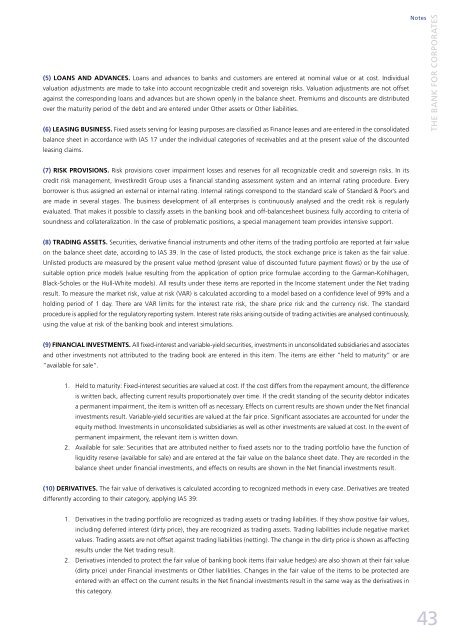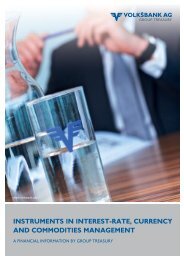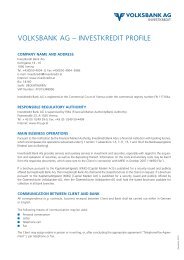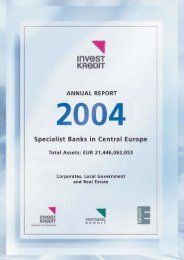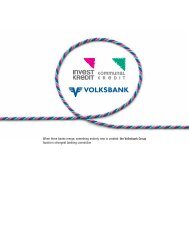Download - Volksbank AG
Download - Volksbank AG
Download - Volksbank AG
You also want an ePaper? Increase the reach of your titles
YUMPU automatically turns print PDFs into web optimized ePapers that Google loves.
(5) LOANS AND ADVANCES. Loans and advances to banks and customers are entered at nominal value or at cost. Individual<br />
valuation adjustments are made to take into account recognizable credit and sovereign risks. Valuation adjustments are not offset<br />
against the corresponding loans and advances but are shown openly in the balance sheet. Premiums and discounts are distributed<br />
over the maturity period of the debt and are entered under Other assets or Other liabilities.<br />
(6) LEASING BUSINESS. Fixed assets serving for leasing purposes are classified as Finance leases and are entered in the consolidated<br />
balance sheet in accordance with IAS 17 under the individual categories of receivables and at the present value of the discounted<br />
leasing claims.<br />
(7) RISK PROVISIONS. Risk provisions cover impairment losses and reserves for all recognizable credit and sovereign risks. In its<br />
credit risk management, Investkredit Group uses a financial standing assessment system and an internal rating procedure. Every<br />
borrower is thus assigned an external or internal rating. Internal ratings correspond to the standard scale of Standard & Poor’s and<br />
are made in several stages. The business development of all enterprises is continuously analysed and the credit risk is regularly<br />
evaluated. That makes it possible to classify assets in the banking book and off-balancesheet business fully according to criteria of<br />
soundness and collateralization. In the case of problematic positions, a special management team provides intensive support.<br />
(8) TRADING ASSETS. Securities, derivative financial instruments and other items of the trading portfolio are reported at fair value<br />
on the balance sheet date, according to IAS 39. In the case of listed products, the stock exchange price is taken as the fair value.<br />
Unlisted products are measured by the present value method (present value of discounted future payment flows) or by the use of<br />
suitable option price models (value resulting from the application of option price formulae according to the Garman-Kohlhagen,<br />
Black-Scholes or the Hull-White models). All results under these items are reported in the Income statement under the Net trading<br />
result. To measure the market risk, value at risk (VAR) is calculated according to a model based on a confidence level of 99% and a<br />
holding period of 1 day. There are VAR limits for the interest rate risk, the share price risk and the currency risk. The standard<br />
procedure is applied for the regulatory reporting system. Interest rate risks arising outside of trading activities are analysed continuously,<br />
using the value at risk of the banking book and interest simulations.<br />
(9) FINANCIAL INVESTMENTS. All fixed-interest and variable-yield securities, investments in unconsolidated subsidiaries and associates<br />
and other investments not attributed to the trading book are entered in this item. The items are either ”held to maturity” or are<br />
”available for sale”.<br />
1. Held to maturity: Fixed-interest securities are valued at cost. If the cost differs from the repayment amount, the difference<br />
is written back, affecting current results proportionately over time. If the credit standing of the security debtor indicates<br />
a permanent impairment, the item is written off as necessary. Effects on current results are shown under the Net financial<br />
investments result. Variable-yield securities are valued at the fair price. Significant associates are accounted for under the<br />
equity method. Investments in unconsolidated subsidiaries as well as other investments are valued at cost. In the event of<br />
permanent impairment, the relevant item is written down.<br />
2. Available for sale: Securities that are attributed neither to fixed assets nor to the trading portfolio have the function of<br />
liquidity reserve (available for sale) and are entered at the fair value on the balance sheet date. They are recorded in the<br />
balance sheet under financial investments, and effects on results are shown in the Net financial investments result.<br />
(10) DERIVATIVES. The fair value of derivatives is calculated according to recognized methods in every case. Derivatives are treated<br />
differently according to their category, applying IAS 39:<br />
1. Derivatives in the trading portfolio are recognized as trading assets or trading liabilities. If they show positive fair values,<br />
including deferred interest (dirty price), they are recognized as trading assets. Trading liabilities include negative market<br />
values. Trading assets are not offset against trading liabilities (netting). The change in the dirty price is shown as affecting<br />
results under the Net trading result.<br />
2. Derivatives intended to protect the fair value of banking book items (fair value hedges) are also shown at their fair value<br />
(dirty price) under Financial investments or Other liabilities. Changes in the fair value of the items to be protected are<br />
entered with an effect on the current results in the Net financial investments result in the same way as the derivatives in<br />
this category.<br />
Notes<br />
THE BANK FOR CORPORATES<br />
43


